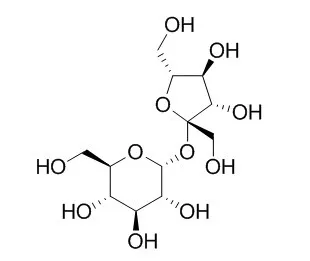| In vitro: |
| Appl Microbiol Biotechnol. 2014 Nov;98(21):9033-44. | | Escherichia coli W shows fast, highly oxidative sucrose metabolism and low acetate formation.[Pubmed: 25125039] | Sugarcane is the most efficient large-scale crop capable of supplying sufficient carbon substrate, in the form of Sucrose, needed during fermentative feedstock production. However, Sucrose metabolism in Escherichia coli is not well understood because the two most common strains, E. coli K-12 and B, do not grow on Sucrose.
METHODS AND RESULTS:
Here, using a Sucrose utilizing strain, E. coli W, we undertake an in-depth comparison of Sucrose and glucose metabolism including growth kinetics, metabolite profiling, microarray-based transcriptome analysis, labelling-based proteomic analysis and (13)C-fluxomics. While E. coli W grew comparably well on Sucrose and glucose integration of the omics, datasets showed that during growth on each carbon source, metabolism was distinct. The metabolism was generally derepressed on Sucrose, and significant flux rearrangements were observed in central carbon metabolism. These included a reduction in the flux of the oxidative pentose phosphate pathway branch, an increase in the tricarboxylic acid cycle flux and a reduction in the glyoxylate shunt flux due to the dephosphorylation of isocitrate dehydrogenase. But unlike growth on other sugars that induce cAMP-dependent Crp regulation, the phosphoenol-pyruvate-glyoxylate cycle was not active on Sucrose. Lower acetate accumulation was also observed in Sucrose compared to glucose cultures. This was linked to induction of the acetate catabolic genes actP and acs and independent of the glyoxylic shunt.
CONCLUSIONS:
Overall, the cells stayed highly oxidative. In summary, Sucrose metabolism was fast, efficient and led to low acetate accumulation making it an ideal carbon source for industrial fermentation with E. coli W. | | Int J Oral Sci. 2014 Dec;6(4):195-204. | | Metabolic activity of Streptococcus mutans biofilms and gene expression during exposure to xylitol and sucrose.[Pubmed: 25059251] | The objective of the study was to analyse Streptococcus mutans biofilms grown under different dietary conditions by using multifaceted methodological approaches to gain deeper insight into the cariogenic impact of carbohydrates.
METHODS AND RESULTS:
S. mutans biofilms were generated during a period of 24 h in the following media: Schaedler broth as a control medium containing endogenous glucose, Schaedler broth with an additional 5% Sucrose, and Schaedler broth supplemented with 1% xylitol.
The confocal laser scanning microscopy (CLSM)-based analyses of the microbial vitality, respiratory activity (5-cyano-2,3-ditolyl tetrazolium chloride, CTC) and production of extracellular polysaccharides (EPS) were performed separately in the inner, middle and outer biofilm layers. In addition to the microbiological sample testing, the glucose/Sucrose consumption of the biofilm bacteria was quantified, and the expression of glucosyltransferases and other biofilm-associated genes was investigated. Xylitol exposure did not inhibit the viability of S. mutans biofilms, as monitored by the following experimental parameters: culture growth, vitality, CTC activity and EPS production. However, xylitol exposure caused a difference in gene expression compared to the control. GtfC was upregulated only in the presence of xylitol. Under xylitol exposure, gtfB was upregulated by a factor of 6, while under Sucrose exposure, it was upregulated by a factor of three. Compared with glucose and xylitol, Sucrose increased cell vitality in all biofilm layers. In all nutrient media, the intrinsic glucose was almost completely consumed by the cells of the S. mutans biofilm within 24 h. After 24 h of biofilm formation, the multiparametric measurements showed that xylitol in the presence of glucose caused predominantly genotypic differences but did not induce metabolic differences compared to the control.
CONCLUSIONS:
Thus, the availability of dietary carbohydrates in either a pure or combined form seems to affect the cariogenic potential of S. mutans biofilms. |
|






 Cell. 2018 Jan 11;172(1-2):249-261.e12. doi: 10.1016/j.cell.2017.12.019.IF=36.216(2019)
Cell. 2018 Jan 11;172(1-2):249-261.e12. doi: 10.1016/j.cell.2017.12.019.IF=36.216(2019) Cell Metab. 2020 Mar 3;31(3):534-548.e5. doi: 10.1016/j.cmet.2020.01.002.IF=22.415(2019)
Cell Metab. 2020 Mar 3;31(3):534-548.e5. doi: 10.1016/j.cmet.2020.01.002.IF=22.415(2019) Mol Cell. 2017 Nov 16;68(4):673-685.e6. doi: 10.1016/j.molcel.2017.10.022.IF=14.548(2019)
Mol Cell. 2017 Nov 16;68(4):673-685.e6. doi: 10.1016/j.molcel.2017.10.022.IF=14.548(2019)